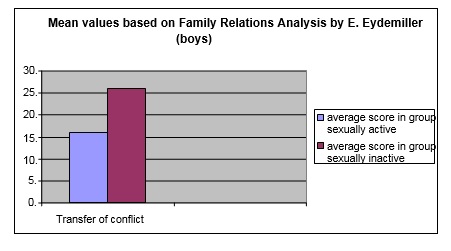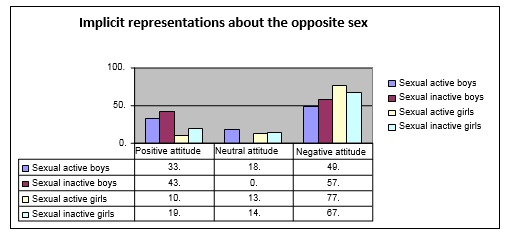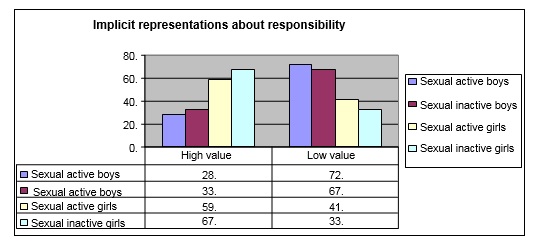Early teenage sexual relations are a wide-spread phenomenon having consequences which are largely unclear. This underlies the relevance of research into the issue. Sexual experience implies lowering of the sexual début age and engenders an array of problems: deviations in personal development; deterioration of interpersonal relations; psychological traumas; increase in socially significant diseases and early pregnancies [Rean 2007; Regush 2005; Roper 1994].
The attempts to identify the drivers, including personal ones, prompting or preventing early sexual relation have been undertaken by a number of sciences. According to research literature, teenage sexual relations are determined by motivation and values, self-concept, relations with the closest friends and relatives, and personality traits [Kazanskaya 2008; Kon 2001; Helmius 2003; Williams and Kelly 2005]. The scope of the current research was defined by the lack of convincing academic views on this issue.
This research aims to study personality traits of sexually active teenagers.
The following hypotheses were put forward:
1. Provided the teenagers in the study are sexually active, they might be expected to be more communicative and vigorous than average.
2. Cognitive interest, hedonistic motives and emotionally distant parents are the factors that prompt teenage sexual relations.
3. Sexual experience has a gender-specific effect on self-concept and constitutes a way of self-fulfilment.
The present research has goals as follows: to analyse contemporary research ideas concerning personality traits of sexually active teenagers; to examine implicit representations with regard to sexual intercourse and basic values; to consider gender-specific features of personality, motivation, self-fulfilment, self-concept, and parent-child relations; to examine the links between psychological features of teenagers and the character of sexual relations they are engaged in.
The study comprises 405 school students in St. Petersburg aged 14-16 (228 boys, 177 girls) and 60 mothers of the students surveyed. The students were divided into four groups: sexually active teenagers (228 teenagers: 128 boys and 100 girls); teenagers not engaged in sexual relations but having a boy- or a girlfriend (177 teenagers: 100 boys and 77 girls). There were also surveyed 60 mothers of the respondents.
The following methods and techniques were employed in the research as the most appropriate: Freiburg Personality Inventory (FPI, Form B) by J. Fahrenberg [Golovey 2001]; eight personality factor questionnaire by L. Gordon [Kon 2001]; self-image test and questionnaire by V. Stolin [Stolin and Panteleev 1988]; Teenagers About Parents by L. Vasserman [Vasserman 2004]; Family Relations Analysis technique by E. Eydemiller [Eydemiller 1996]; Self-Fulfilment Test by L. Gozman [Gozman et al. 1995]; a modified version of the open-ended sentences by Zh.M. Saks and S. Levi [Golovey 2001]; and My Sexual Relations Questionnaire developed by the authors of this research.
The mathematical methods included: nominal data analysis by Pearson's chi-squared test; comparative analysis by Student's t-test for independent samples; comparative analysis using Mann-Whitney U-test for independent samples; correlation analysis using Pearson correlation coefficient; analysis of variance using Fisher's F-criterion; discriminant function analysis using Wilks's lambda distribution; implicit representations analysis.
Table 1.
Comparative analysis using Gordon's questionnaire and Fahrenberg's FPI.
|
Personality determinant |
Average among sexually active boys |
Average among sexually inactive boys |
Student's t-test |
Sig |
|
Dominance |
27.57 |
18.34 |
8.352 |
0.001 |
|
Emotional stability |
28.22 |
23.49 |
3.826 |
0.001 |
|
Vigorousness |
27.96 |
19.86 |
7.112 |
0.001 |
|
Trust in relations |
26.43 |
21.21 |
4.754 |
0.001 |
|
Communicativeness |
27.36 |
17.57 |
8.520 |
0.001 |
|
Caution in decision-making |
29.29 |
21.70 |
6.495 |
0.001 |
|
Openness |
4.85 |
3.92 |
3.470 |
0.001 |
|
Reactive aggressiveness |
7.14 |
6.51 |
2.630 |
0.009 |
|
Emotional lability |
5.48 |
6.32 |
-3.349 |
0.001 |
|
Masculinity |
5.63 |
4.79 |
2.271 |
0.007 |
|
Extroversion |
5.69 |
5.17 |
2.517 |
0.013 |
|
Personality determinant |
Average in group of sexually active girls |
Average in group of sexually inactive girls |
Student's t-test |
Sig |
|
Dominance |
22.12 |
17.98 |
3.879 |
0.001 |
|
Vigorousness |
23.12 |
20.31 |
3.205 |
0.002 |
|
Need in communication |
23.32 |
19.15 |
4.001 |
0.001 |
|
Timidity |
7.30 |
6.42 |
3.260 |
0.001 |
|
Impulsiveness |
7.63 |
6.43 |
3.664 |
0.001 |
|
Masculinity |
5.70 |
4.87 |
2.398 |
0.018 |
|
Emotional lability |
7.68 |
6.70 |
3.939 |
0.001 |
According to Table 1, sexually active teenagers of both sexes tend to be domineering, vigorous, and masculine.
Furthermore, girls display such qualities as emotional instability, impulsiveness, and timidity. Therefore, girls use sexual relations as a way of communication enabling them to join the peer group. Similar results were obtained by I.S. Kon [2001]. Sexually active boys are more communicative, emotionally stable, and cautious in decision-making.
The discriminant function analysis indicated the following determinants which are most likely to underlie girls' sexual activity: need in communication (λ=0,502; p=0,001), conformity (λ=0,345; p=0,001), and emotional lability (λ=0,431; p=0,001). For boys, these determinants are dominance (λ=0,397; p=0,001) and caution in decision-making (λ=0,468; p=0,001). For all the teenagers, their gender notwithstanding, the features of parent-child relations turned out to be important factors triggering sexual intercourse.
Table 2.
Comparative analysis using Vasserman's Teenagers About Parents technique
|
Personality determinant |
Average among sexually active boys |
Average among sexually inactive boys |
Student's t-test |
Sig |
|
Intimacy with mother |
2.29 |
3.05 |
-3.737 |
0.001. |
|
Mother's inconsistency in relations |
3.73 |
3.16 |
2.554 |
0.012. |
|
Farther's autonomy |
1.62 |
3.37 |
-7.754 |
0.001. |
|
Father's positive interest |
1.54 |
2.62 |
-4.097 |
0.047. |
|
Personality determinant |
Average among sexually active girls |
Average among sexually inactive girls |
Student's t-test |
Sig |
|
Mother's autonomy |
3.70 |
2.94 |
3.859 |
0.001. |
|
Intimacy with farther |
2.26 |
2.98 |
-3.842 |
0.001. |
|
Father's hostility |
3.58 |
3.02 |
2.406 |
0.017. |
|
Father's inconsistency in relations |
3.77 |
3.24 |
2.575 |
0.011. |
The parents of sexually active teenagers (Table 2) are characterised as emotionally distant; fathers are little involved with their child.
Sexual activity of girls is often linked to their fathers being critical about them (λ=0,557; p=0,001), which makes such girls search for male attention. The boys' sexual life is, conversely, determined by undemanding behaviour of fathers (λ=0,641; p=0,001) and autonomy of mothers (λ=0,815; p=0,001). Such boys do not receive any clear system of demands from their parents.
Mothers of 38 boys and 22 girls were surveyed in order to identify the difference in the view upon the family relations held by children and their parents. The comparative analysis was carried out using Mann-Whitney U-criterion for small samples with abnormal distribution.
Mothers of sexually inactive boys (Picture 1) more often believe they tend to transfer their problems with the husband to the upbringing process (U=43,000; p=0,017).

Pic.1. Mean values based on Family Relations Analysis technique by E. Eydemiller
In case of conflict among parents, their views are usually diametrically opposite: mothers report they are strict, with more than average use of prohibitions, sanctions, and demands; such mothers perceive their husbands as inappropriately compassionate towards children and ready to bow to the children's wishes.
Table 3.
Results of Family Relations Analysis by E. Eydemiller
|
Parenting style |
Average among sexually active teenagers |
Average among sexually inactive teenagers |
Student's t-test |
Sig |
|
Teenager's needs are ignored |
4.700 |
2.222 |
2.664 |
0.016 |
|
Unstable parenting style |
4.300 |
2.666 |
2.869 |
0.011 |
|
Projection of parents' undesirable qualities onto the teenager |
4.400 |
3.111 |
2.782 |
0.013 |
|
Preference given to female qualities |
4.200 |
3.110 |
2.559 |
0.045 |
|
Transfer of conflict |
3.900 |
2.222 |
2.258 |
0.037 |
Mothers of girls report (Table 3) they fail to fully meet spiritual and emotional needs of their daughters. The mothers assess their own behaviour as unstable: with alteration of strict discipline and a liberal style; and of increased attention and emotional rejection. We believe it is the projection mechanism constitutes the reason of such parenting behaviour. Mothers ascribe to their daughters those qualities that they find it difficult to accept in themselves.
Table 4.
Comparative analysis using V. Stolin's self-concept test and questionnaire
|
Personality determinant |
Average among sexually active boys |
Average among sexually inactive boys |
Student's t-test |
Sig |
|
Expectation of positive attitude from others |
58.684 |
48.719 |
2.403 |
0.017 |
|
Self-interest |
63.097 |
53.409 |
2.289 |
0.023 |
|
Self-accusation |
51.542 |
41.380 |
2.838 |
0.005 |
|
Personality determinant |
Average among sexually active girls |
Average among sexually inactive girls |
Student's t-test |
Sig |
|
Behaviour flexibility |
10.45 |
12.57 |
-3.125 |
0.002 |
|
Sociability |
8.01 |
9.40 |
-3.547 |
0.001 |
|
Orientation in time |
7.57 |
9.44 |
-4.263 |
0.001 |
|
Support |
44.59 |
47.68 |
-2.753 |
0.007 |
|
Cognitive needs |
4.78 |
5.41 |
-2.907 |
0.004 |
|
Self-acceptance |
9.22 |
10.44 |
-2.929 |
0.004 |
|
Self-respect |
9.67 |
8.45 |
2.604 |
0.010 |
|
Values orientation |
12.00 |
10.89 |
2.544 |
0.012 |
The results of V. Stolin's technique (Table 4) allow to conclude that sexually active boys more often expect positive attitude from others; their self-interest is higher, but self-accusation is higher, too. The girls are characterised by low self-management, i.e. they have difficulties predicting the results of their actions.
In terms of motivation, all teenagers surveyed explain their behaviour by the desire to learn something new. This motive has the most structural links among teenagers. Furthermore, boys are mostly characterised by hedonistic motives, while girls - by the communicative, or social, ones (t=0,091; p=0,011).
The hedonistic motives among boys are linked to their self-concept (self-management and self-liking). Conversely, no correlation between personality features, self-concept and hedonistic motives was established for girls.
The Self-Fulfilment Test by L. Gozman yielded the following results (Tables 5, 6).
Table 5.
Comparative analysis using The Self-Fulfilment Test by L.Ya. Gozman
|
Personality determinant |
Average among sexually active girls |
Average among sexually inactive girls |
Student's t-test |
Sig |
|
Behaviour flexibility |
10.45 |
12.57 |
-3.125 |
0.002 |
|
Sociability |
8.01 |
9.40 |
-3.547 |
0.001 |
|
Orientation in time |
7.57 |
9.44 |
-4.263 |
0.001 |
|
Support |
44.59 |
47.68 |
-2.753 |
0.007 |
|
Cognitive needs |
4.78 |
5.41 |
-2.907 |
0.004 |
|
Self-acceptance |
9.22 |
10.44 |
-2.929 |
0.004 |
|
Self-respect |
9.67 |
8.45 |
2.604 |
0.010 |
|
Values orientation |
12.00 |
10.89 |
2.544 |
0.012 |
The following personality features are the most pronounced among sexually inactive girls: personal independence (or internal locus of control), high adaptivity, willingness to be guided by their own goals, beliefs, attitudes, and principles; lack of hostility towards others; flexible behaviour; ability to set up friendly relations.
Sexually active girls, on the contrary, are more dependent on the majority opinion and are 'outward-oriented'. Two groups were identified among sexually active girls. The first group comprises those who have high scores in personality traits which facilitate self-fulfilment. Such girls often initiate sexual contacts themselves, have long-term love relations, and use sex to become closer with a partner and to experience the fullness of life. The second group includes girls with low scores in personality traits linked to self-fulfilment. They are mainly engaged in short-term relations and are more oriented towards giving pleasure to a partner. They use sex to acquire new experience and relieve both sexual and emotional stress.
Table 6.
Comparative analysis using The Self-Fulfilment Test by L. Gozman
|
Personality determinant |
Average among sexually active boys |
Average among sexually inactive boys |
Student's t-test |
Sig |
|
Self-respect |
8.73 |
7.60 |
2.699 |
0.008 |
|
Creativity |
6.53 |
5.45 |
3.337 |
0.001 |
|
Acceptance of aggression |
8.31 |
7.30 |
2.843 |
0.005 |
|
Values orientation |
11.16 |
9.45 |
3.251 |
0.001 |
Sexually active boys are characterised by higher scores in all personality traits connected to self-fulfilment. The pronounced degree of the acceptance of aggression attracts special interest. We believe this aids in establishing inter-personal relations and fosters openness to life experience. The analysis of variance revealed that the beginning of sexual life influences certain aspects of self-concept. The girls show increase in self-esteem (F=8,579; p=0,004), since sexual contacts in part help them to overcome self-underestimation, i.e. they become more tolerant. The boys show rise in self-respect (F=10,863; p=0,001).

Pic. 2. Implicit representations about the opposite sex
The analysis carried out to identify the attitude to the opposite sex (Picture 2) showed that the majority of teenagers, especially the sexually active ones, have reported strongly negative attitudes. In general, girls tend to be more critical, while boys are by far more tolerant about girls.

Pic. 3. Implicit representations about love
The analysis revealed that sexually active teenagers devalue the role of love: they are little aware of this concept and equate love to sex (Picture 3). Boys more often characterise love in a negative way. Girls in platonic relations attribute more meaning to love, which might be a constraining factor for entering a sexual intercourse. Conversely, boys give absolutely no thought to the notion.

Pic. 4. Implicit representations about responsibility
As follows from Picture 4, sexually active teenagers devalue the role of responsibility more frequently, though there are gender-specific differences: girls have a higher degree of awareness in this regard.
The major results:
- The personality traits of sexually active teenagers include vigorousness, masculinity, and tendency to dominate. Boys are mostly driven by cognitive and hedonistic motives. Girls are mostly driven by the cognitive and social (communicational) ones.
- The majority of the teenagers surveyed are characterised by negative and/or critical attitude to the opposite sex. This does not depend on previous sexual experience. In general, girls are more forthright and uncompromising in their criticism.
- The analysis of implicit representations revealed that sexually active teenagers do not realise the basic values and underplay their role.
- The discriminant function analysis established the significance of additional factors which trigger sexual relations among teenagers. For girls, these include the state of being in love, dependence on majority opinion, and emotional lability. For boys, such factors are dominance and independence in decision-making.
- Sexually active teenagers are engaged in numerous social interactions of a superfluous nature. However, these interactions do not lower their compelling need for emotional intimacy.
- It was revealed, that 27% of the teenagers surveyed are engaged in 'relatively harmonious' relations, and their sexual experience does not deform their personalities. This is the case when the partners share common values and are responsible for their actions towards each other. In terms of behaviour, this implies stable relations with one partner, feeling of love, and permanent use of contraception.
- Teenage sex is provoked by emotional distance from parents and lack of systematic discipline.
- The study revealed that sexually active boys share their mothers' views upon family relations. A different situation obtains with girls: their consider their mothers undemanding, while the mothers believe they are strict. The majority of teenagers surveyed use sexual relations as a way to explore the world, resulting in greater self-respect of boys and increased self-acceptance of girls.